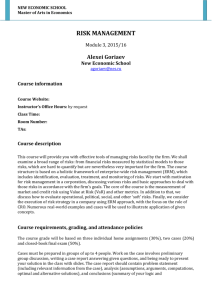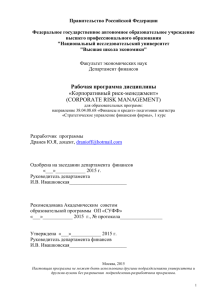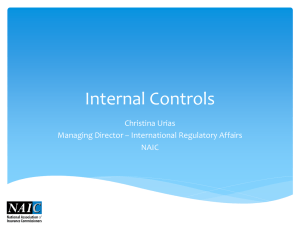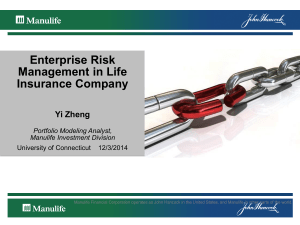Enterprise Risk Management For Insurers and Financial Institutions
advertisement
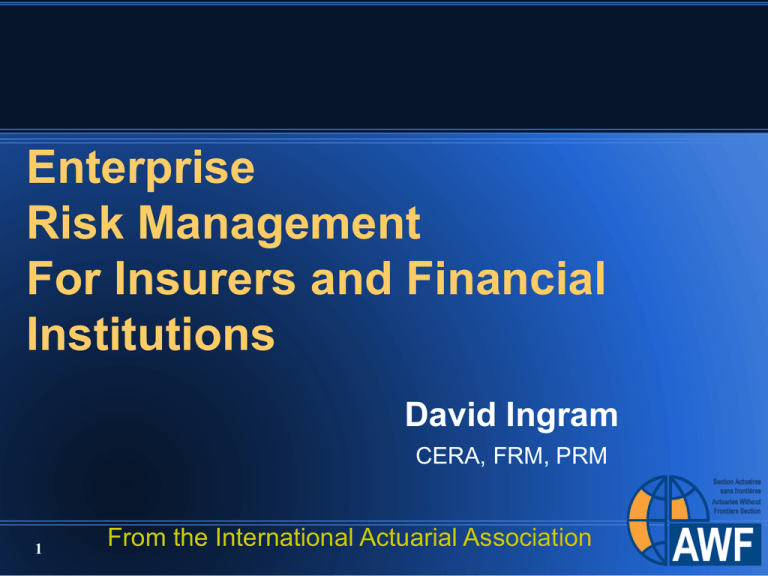
Enterprise Risk Management For Insurers and Financial Institutions David Ingram CERA, FRM, PRM 1 From the International Actuarial Association Course Outline 1. INTRODUCTION - Why ERM? 2. RISK MANAGEMENT FUNDAMENTALS – FIRST STAGE OF CREATING AN ERM PROGRAM 3. RISK ASSESSMENT AND RISK TREATMENT - ACTUARIAL ROLES 4. ADVANCED ERM TOPICS 2 ERM FUNDAMENTALS FIRST STAGE OF CREATING AN ERM PROGRAM 2.1 Risk Identification: systematic identification principal risks 2.2 Risk Language: explicit firmwide words for risk and Risk Management 2.3 Risk Measurement: What gets measured gets managed 2.4 Risk Management Policies and Standards: Clear and comprehensive documentation 2.5 Risk Organization: Roles & Responsibilities 2.6 Risk Limits: Set, track, enforce 2.7 Risk Management Culture: ERM & the staff 2.8 Risk Learning: Commitment to constant improvement 2.9 Developing a First Stage Implementation Plan 3 2.1 Risk Identification: Systematic identification principal risks Two Common Methods: 4 Top Down Bottom Up Risk Identification: Top Down Takes One Day Top Management Buy In Results in something that is at the right level of detail for top management & Board Advantages Requires One Day of Top Management Attention Might Miss Something Middle Management might buy in Requires staff time to go Disadvantages 5 Bottom Up Likely to Capture all risks Sometimes Middle Management buy in May be at an actionable level for middle management Takes a Full Year Might not be accepted by Top Management Requires plenty of staff time to summarize for Top Management & Board Top Down Key Risks & Controls Workshop 1) 2) 3) 4) 5) 6 Risk Identification Risk Assessment Risk Control Assessment Heat Map Development Risk Plan Risk Identification A List of Risks Facing Insurers (compiled by Dave Babbel, Wharton School) CORPORATE Capital Utilization Expense Control, Overhead Burden Regulatory Compliance Ethics & Employee Behavior Accountability Meritocracy Quality of Management Quality of Training Quality of Workforce, Service Management Succession Recruitment/Retention Industry Reputation Industry Concentration Company Reputation Teamwork Over Turf Coping With Change Technological Breakdown Nontraditional Ventures Guaranty Fund Assessments Tax Law Changes Uninsured Pure Firm Losses Information Systems Problems Legal Risk Financial Disclosure Risk Which are your Risks? Insurance Risk Credit Risk ASSET SIDE Market Risk ERM Liquidity Risk Operational Risk Group Risk 7 Credit Public Bonds Private Placements Mortgages Collateral Risk Counterparty Risk Reinsurer Insolvency Systematic Risks: Interest Rate Risk Call Risk - Callable Bonds Prepayment Risk - MBS & CMO Duration, Convexity, Drift Change in Interest Volatility Yield Curve Shape, Twist Systematic Risks: Other Equity Market Risk Basis Risk Inflation Risk Liquidity Cash Mismatch Disintermediation Run on the "Bank" Maturity Extension Mortgage Refinancing Loss of Equity Value Real Estate Stocks Subsidiaries Derivatives Diversification Asset Allocation Industry and Geographical Risk Unstable Covariances Risk Political & Currency International Investments Foreign Exchange Risk Terrorism LIABILITY SIDE Pricing Pricing Adequacy Expense Margin Unrealistic Competition Policy Lapses Long Tail of Liabilities Inflation Risk Actuarial Mortality Morbidity Longevity Subsidized Early Retirement Disintermediation Secular Trend Utilization of Covenants Antiselection Natural Catastrophe Moral Hazard Fraudulent Information Fraudulent Claims Morale Hazard Product Development Product Design Product Appeal Consumer Misunderstandings Distribution Cost of Distribution Agent Recruitment Agent Productivity Agent Retention Policy Churning Regulatory Environment Compliance Loss of Tax Benefits Health Care Reform Other Regulatory Changes Financial Reporting Surplus Strain GAAP for Mutuals FAS 115 Unsound Reporting Mark-to-Market Risk Reputation Ethics & Compliance Quality of Service Corporate Image Market Uncontrolled Growth Untested Markets Market Saturation Bank Competition Globalization Liability Insurance Political & Currency Foreign Exchange Risk of Claims Profits Repatriation Political Risk Terrorism SURPLUS Capital Adequacy Funding Risk Risk Assessment 8 How Significant are your risks? Subjective Assessment Consensus view Frequency Severity Risk Control Assessment 9 For Most Significant Risks How effective are your existing control processes? For the best controlled risks, how much risk is left after the control process? Are they still significant? Subjective Assessment Not as easy to reach consensus Heat Map Development Risk Control Self Assessment Risk Significance Risk & Control Heat Map Large Medium Small More Effective Control Less Effective Control Low Priority Moderate Priority High Priority 10 Risk Control Plan Choose High Priority Risks to address this year Plan will be to: Prepare detailed documentation of existing control processes Research and identify best practice control processes Compare existing to best practice Choose improvements to make Implement improvements 11 2.2 Risk Language: Explicit firmwide words for risk and Risk Management RISK WORDS Start with LOSS 12 What are the words for the worst thing that has happened? In the past quarter? In the past year? Ever? Realistic Loss Terminology 13 Good – Company meets plans, bonuses paid Adverse – Company fails to meet plans by significent margin, no bonuses paid. May be some layoffs. Terrible – Company shows significant loss. Top management loses jobs Horrible – Company suffers large loss. Downgraded (or other bad publicity) causes company to lose ability to sell new business Disaster – Company loses almost all surplus. Taken over by regulators Substitute your own words Risk Terminology Frequency & Severity Does “High Severity” mean the same thing in different departments? Do different departments have similar time frames in mind? 14 Risk Management Terminology 15 What is it called when someone doing risk management? Risk Treatment Risk Mitigation Underwriting Hedging ALM Quality Control Make a List 16 Of Risk & Risk Management words that we use this week that are NOT part of company vocabulary And another list of words that are used 2.3 Risk Measurement: What gets measured gets managed Includes: Gathering data, risk models, multiple views of risk and standards for data and models. 17 Risk Measurement – Minimal Practice Do not have needed data readily available Models for some risks Only one measure of risks where there are any May be calculating something that is slightly or significantly different from risk definition 18 Adequate Risk Measures 1. Information is not too late to drive any action 2. Gives broad indication of the amount of risk – mostly reflecting differences to volumes 3. Inexpensive 4. May be understood by primary users and misunderstood by occasional users 19 Good Risk Measure 1. Timely 2. Accurately distinguishes broad degrees of riskiness within the broad risk class 3. Not too expensive or time intensive to produce 4. Understood by all who must use 5. Actionable 20 Excellent Risk Measure Good Risk Measure Plus 6. Can help to identify changes to risk quality 7. Provides information that is consistent across different Broad Classes of Risk 8. For most sensitive risks will pinpoint variations in risk levels 21 Best Practices Risk Measurement Gathering data for risk measurement is regular output of operational processes Risk Models exist and are used for every risk Multiple views of risk are developed 22 Risk Measurements are consistent with Risk definitions & Risk Language Clear standards for Data, Models and measures of risk Improving Risk Measurement Identify existing risk measures Classify as Adequate, Good, Excellent 23 Look to create additional risk measures where needed Look to improve quality of measures where needed Risk Measures RISK 1. 2. 3. 24 Measure Quality Keep, Improve, Add? Risk Measurement 25 Risk Assessment Risk Metrics Gross Exposure Expected Losses Volatility of Losses Ruin / Tail Losse Gross Exposure Credit – Amount invested in single group of companies (Name) Equity Market Risk – Direct Holdings + Separate Account Holdings + Maximum value of guarantees Interest Market Risk – Direct Holdings Insurance – Face Amount + Max Probable Loss Operational – Largest losses known adjusted by size of operation Expected Losses Credit – Average per period Expected Loss over cycle – Maximum Loss per period over cycle Market – may not apply Insurance – Net Premium Operational – Average losses per period Volatility of Losses Market, Credit, Insurance Standard Deviation of losses based on: Historical experience Expected future of next cycle Implied Volatility from market price of derivatives Ruin / Tail Losses Stress Tests VaR CTE Risk Measurement Tools Market Risk Measures General & Insurance Measures A/E Experience Monitoring Cash Flow Testing Liquidity Analysis Duration Scenario Analysis Stress Testing Convexity Embedded Value Value at Risk Earnings at Risk Option Adjusted Spread Probable Maximum Loss Sharpe Ratio Performance Attribution Earnings by Source Key Rate Durations RBC Ratios Tracking Error A/E Experience Monitoring Actual experience is regularly compared to pricing and\or budget\plan expectations to show the degree to which liability assumptions are being met. Trend analysis is often performed on A/E ratios to see whether to expect continuation of favorable or unfavorable experience. Stress Testing Process to identify and manage situations that could cause extraordinary losses. Stress Testing uses scenario analysis, stress models, correlations and volatilities, and policy responses. Probable Maximum Loss The maximum loss that is incurred for the entire company in a predefined disaster scenario situation. PML is usually the ultimate stress test selected subjectively by the company management to reflect the worst situation that they think has any significant likelihood. PML is also the term sometimes used to describe the exposure to loss from a single event such as a natural disaster or the default of a bond issuer. Scenario Analysis Evaluation of the asset and liability portfolios under various economic assumptions. Typically involves large movements in key variables and full cash flow projections. Liquidity Analysis Analysis of a company’s ability to withstand a stress liquidity situation over a short term horizon. The analysis takes into account the company’s capital position, the liquidity of the asset portfolio, the surrender potential of the liability portfolio, the degree of cash matching employed, the number of contractholders, distribution channels, target markets and size of the company. Embedded Value The present value of future profits that are “embeded” in the existing inforce business. May be best estimates discounted at a risk adjusted interest rate. Some use accounting system profits (with margins for adverse deviation) and discount at an after-tax return on underlying assets Used as a proxy for market value of liabilities. Earnings at Risk The expected decrease in earnings over a specified time period within a given confidence level. Using GAAP values avoids some of the difficult problems of marking insurance company liabilities to market. However, the full GAAP impact from a shock to certain risk factors does not necessarily emerge in the short time frame generally captured in these types of calculations. Performance Attribution/ Earnings by Source Process of disaggregating actual return into pre-defined components. This is a retrospective measure that can be designed to show which risk factors are causing losses. RBC Ratios The ratio of RBC to adjusted statutory surplus is used as the standard for surplus adequacy related to company risks. Some companies use Rating Agency surplus formulas while others use internally developed Required Surplus formulas. VaR Value at Risk Quick Measure of Risk – originally for derivatives trading book of bank Has become primary measure for Banks VaR – Monte Carlo Embedded Value Product A 800 600 90th Percentile = 232 400 Expected Value = 498 200 -200 -400 -600 VaR = 498 – 232 = 266 989 951 913 875 837 799 761 723 685 647 609 571 533 495 457 419 381 343 305 267 229 191 153 115 77 39 1 0 VaR Advantages Quick & Easy to calculate Easy to explain and understand Disadvantages Shortcuts commonly used may render result meaningless Ignores much of tail Can be “gamed” VaR Definition: Value at Risk is expected loss at a particular level of probability (usually 95% or 98%) VaR Calculation Methods Historical Mean Variance Simulation Usually calculated for 1 day and extrapolated to 10 days VaR – Historical Calculation Collect historical values for past 250 trading days Rank Values 95% VaR is 238th worst value VaR Mean Variance Calculation Determine Mean and Variance of loss function: Historical Expectations for Future Risk neutral – Implied by Current Market Prices Assuming Normal Distribution of loss, determine 95%/98% loss 95% loss = mean – 1.645 x Std Dev 98% loss = mean – 2.052 x Std Dev VaR Stochastic Calculation Usually used where market values are not available and distribution of losses is know to be non-normal Develop stochastic scenarios of fundamental market elements interest rates, equity CTE Contingent Tail Expectation aka Tail VaR Average of values worse than VaR CTE90 means average of worst 10% of values CTE – Monte Carlo Embedded Value Product A 90 CTE 800 600 90th Percentile = 232 400 Expected Value = 498 200 -200 -400 -600 989 951 913 875 837 799 761 723 685 647 609 571 533 495 457 419 381 343 305 267 229 191 153 115 77 39 1 0 Effective Risk Measurement Relevance Relationship to financial results reporting Comprehensiveness All types of risks All significant aspects of those risks Responsiveness Reflecting changes in levels of risks over reporting period Practicality Schedule comparable to financial results reports Reasonable cost to produce Ability to project alternatives over planning period 2.4 Risk Management Policies and Standards: Clear and comprehensive documentation Clearly document the firm's policies and standards regarding how the firm will take risks and how and when the firm will look to offset, transfer or retain risks. Definitions of risk-taking authorities; definitions of risks to be always avoided; underlying approach to risk management; measurement of risk; validation of risk models; approach to best practice standards. 56 Minimal Practice Some policies are fully documented. Some documentation is out of date. Everybody knows what risks to avoid without writing down. Middle management regularly brings proposals for new projects that are rejected because risk is unacceptable. Risk measures might change at any time. Models are often used without any documented validation. Best practice standards are unknown. No verification of risk management activities. 57 Risk Management Policies Case Study • Large Diversified Company • Risk Management is a strong fundamental cultural value – Operation of Risk Management System – Review of new initiatives – Care & Feeding of RM Culture Operation of RM System • A system of limits and flags – Limits – for credit, market and insurance risk for each company • Timely measurement of exposures • Actual vs. Limit reports are widely distributed • Limits roll-up company and corporate org chart – Every manager up the line has limits • Limits are re-evaluated every year based on financial results, prior period limits and flags Limits and Flags • Flags – Include annual evaluation of macro risks of each business • Regulatory Risk • Political Risk • Credit, Market and Underwriting risk – Portfolio Quality Analysis – Business Performance • Annual review of Flags – Renewal/update of Limits Review of New Initiatives • 10 step process – Several go-no go checkpoints • Including review of proposals for – Risk Measurement – Risk Limits – Risk Mgt – Hedging, Reinsurance, etc. – Risk Management needs to be detailed before significant developmental resources are committed – Review Committee consists of • • • • Chief Actuary Chief Risk Officer (May be Chief Actuary) CFO Chief Marketing Officer Care & Feeding of RM Culture 1. Installing RM process is a major part of any acquisition 90 day transition process 2. Risk Officer position established in every business unit 3. Expectations of Risk Officer are uniform across firm Risk Officers are provided with tools to comply with corporate requirements Intranet website contains full sets of templates and actual reports Global Risk Officer meetings Risk Management Policy Statement From Manulife Annual Report goal in managing risk is to strategically optimize risk taking and risk management to support longterm revenue and earnings growth, and shareholder value growth. seek to achieve this by capitalizing on business opportunities that are aligned with the Company’s risk taking philosophy, risk appetite and return expectations, • by identifying, monitoring and measuring all keyrisks taken, and • by proactively executing effective risk control and mitigation programs. Risks will only be assumed that are • prudent in relation to the Company’s capital strength and earnings capacity, • are aligned with our operational capabilities, • meet our corporate ethical standards, • allow us to remain diversified across risk categories, businesses andgeographies, and • for which we expect to be appropriately compensated. What Additional Policies & Standards • Need to exist to make the Manulife Policy Statement totally effective? 1. 2. 3. More from Manulife To ensure consistency, these strategies incorporate policies and standards of practice that are aligned with those within the enterprise risk management framework, covering: • " Assignment of risk management accountabilities across the organization; • " Delegation of authorities related to risk taking activities; • " Philosophy related to assuming risks; • " Establishment of specific risk limits; • " Identification, measurement, monitoring, and reporting of risks; and • " Activities related to risk control and mitigation. Potential Topics for Policies & Standards 2.1 Risk Identification: systematic identification principal risks 2.2 Risk Language: explicit firmwide words for risk and Risk Management 2.3 Risk Measurement: What gets measured gets managed 2.4 Risk Management Policies and Standards: Clear and comprehensive documentation 2.5 Risk Organization: Roles & Responsibilities 2.6 Risk Limits: Set, track, enforce 2.7 Risk Management Culture: ERM & the staff 2.8 Risk Learning: Commitment to constant improvement Basic Elements of Policies & Standards Who, What policy applies to Who approved policy, when effective Actions and communications required Actions prohibited Who has authority to grant exceptions to policy, modify policy Consequences of violation of policy 2.5 Risk Organization: Roles & Responsibilities Coordination of ERM through: High-level risk committees; risk owners; Chief Risk Officer; corporate risk department; business unit management; business unit staff; internal audit. Assignment of responsibility, authority and expectations. 69 Risk Management Organization Board & Top Management Risk Management Responsibilities • Supporting Risk Management – Decisions, Actions, Incentives, Access • Establishing Risk Mgt Organization • Specifying: – Loss Tolerance – Earnings Volatility Tolerance – Capital Target – Rating Target Supporting Risk Mgt • Decisions – Insisting on Risk information before making decisions – Using Risk information to influence decisions • Actions – Backing enforcement of Risk Mgt policy violations • Incentives – Including risk mgt criteria in incentives – Eliminating incentives that directly work against risk management Establishing Risk Mgt Organization Board Risk Committee Corporate CRO position Corporate Risk Mgt Committee Sufficient Staff Number Training of people Chief Risk Officer Chief Risk Officer Chief Risk Officer Chief Risk Officer Chief Risk Officer Chief Risk Officer Chief Risk Officer Provides Leadership and Vision for ERM Acts as point person in establishing integrated ERM Champion of Intelligent Risk Management Balance of Caution & Encouragement Chief Risk Officer Balancing STOP Caution GO! Act Chief Risk Officer Responsible for Risk Policy Risk Analytics and Reporting Business Unit CRO’s Communication Member of: Capital Management Committee Leader of: Risk Management Committee CRO Staff • • • • Head of Credit Risk Mgt Head of Market Risk Mgt Head of Insurance Risk Mgt Head of Operational Risk Mgt – Insurance Manager Risk Management Committee Members Chief Financial Officer Chief Investment Officer Chief Actuary Internal Auditor Chief Risk Officer Chief Operating Officer Members (possible) • Chief Marketing Officer • Chief Service Officer • Chief Counsel • Chief Underwriter • Chief Information Officer Risk Oversight Committee Responsibilities Review & approve risk policy Oversee enforcement Ensure RM objectives are met Review & approve RM Strategies of business units Periodic review of RM programs especially focusing on impact of environmental changes on impact and effectiveness of programs Review of new products & programs CCRO White Paper Risk Oversight Committee Responsibilities • • • Set & enforce requirements for regular risk reporting Periodic independent review of risk management Review models used to evaluate risks CCRO White Paper Risk & Loss Tolerances • Risk Oversight Committee – Transforms Board & Senior Management Preferences into specific, actionable, clear, measurable standards – Monitoring of compliance with standards – Enforcement of consequences for violations of standards Risk Reporting P&L from risks Current exposure Aggregate By type Largest exposures Limit utilization Record & status of exceptions Risk Management Organization Examples Sun Life of Canada ERM Organization A. Central (Corporate) Risk Office – headed by CRO – 3 Direct Reports - Responsible for: (1) operational risk management & corp ins programs (2) risk assessment & modeling Stds (3) Insurance risk - underwriting, mortality, morbidity & reinsurance – CRO - board mandate - open access throughout company • access to Sr.Mgt. & Board- regularly meets alone w\head of board risk review committee Risk Management Organization A. Board Risk Review Committee B. Exec Risk Committee - chaired by CEO - lead by CRO – President, CFO, Chief Counsel, Appointed Actuary, Inv Risk Management Head, Internal Auditor – Policy Setting - Emerging issues - Monitoring special problems, C. Central Risk Steering Committee – CRO, SBU Risk Officers, SBU auditors, Chief Actuary, Chief Compliance Officer, Chief Auditor – Implementation of RM policy 2.6 Risk Limits: Set, track, enforce Control Cycle Bottom Up / Top Down Process Comprehensively clarifying expectations and limits regarding authority, concentration, size, quality; a distribution of risk targets and limits, as well as plans for resolution of limit breaches and consequences of those breaches. 92 Actuarial Control Cycle 93 COSO Control Cycle Cycle Control Cycle Elements Identify Risks Evaluate Risks Monitor Risks Diversify Risks Limit, Avoid Risks & Offset Risks Transfer Risks New Product Risk & Risk Control Review Process Reporting 96 Risk Control Cycle Assess Plan Adjust Monitor Manage Risk Control Cycle 1. Identify 2. Assess 3. Plan 4. Manage 5. Monitor 6. Adjust Risk Appetite Understanding Risk Capacity (Tolerance) and Risk Appetite (How much of Capacity will be used) Discussions of: Peer Comparisons, RBC, Rating Agency Views, Historical Loss Scenarios, Future Loss Scenarios, Economic Capital, Franchise Value, Effective Risk Appetite, Risk Preferences , earnings volatility, ruin 99 Risk Appetite Key Questions: 1. What have been the most successful decisions over the past 5 – 10 years? 2. What adverse experience was avoided due to management/board actions anddecisions over the past 5 – 10 years? 3. What is the worst experience over the past 20 years? 4. What is the worst experience that a peer company have in the past 20 years? 5. What are the most significant risks at the current time? 6. Where does the company expect to be in relation to peers 5 or 10 years in the future? 7. What are the financial measures that are the most important to management and board? 8. Based upon those financial measures, how would management and board define a great year, a good year, a fair year, a poor year, a terrible year and a disastrous year? 9. What are the sorts of business opportunities that company would never consider doing? would like to be doing more of? might do if the returns look to be very good? 10. How would company see itself performing in a year when experience for the risks taken by company are at a worst in 20 year level? 100 Types of Risk Appetite Statements Ratings Based – Insurer will not take risks that will endanger their rating from AM Best. Risk Based Capital Based – Insurer will maintain an RBC Ratio of at least xxx% Event Based – Insurer will maintain capital to support a loss at least as large as experienced from Hurricane Katrina along with an investment loss like 2001. Probability Based – Insurer will maintain capital so that the probability of a loss exceeding capital is no more than 3 in 10,000 (AA S&P level) Value Based – Insurer will maintain a level of capital the produces the best franchise value for the firm with the risks taken Earnings Based – Insurer will not take any risks that could result in the loss of earnings of more one quarter’s average earnings over the past 5 years. Capital Based – Insurer will not take risks that will produce a loss of more than 25% of capital at the 1/250 probability level. 101 Risk Treatment Risks can be kept within limits by either 1) Controlling the amount of GROSS risk taken to keep it within limits 1) 102 Includes management of the terms of gross risk taken Using Risk Treatment techniques to make sure that NET risk retained is within limits Risk Treatment Techniques Financial Market Risks – Hedging - External/Internal – Asset Liability Management Insurance Risks 103 – Reinsurance – Capital Markets Instruments 2.7 Risk Management Culture: ERM & the staff ERM can be much more effective if there is risk awareness throughout the firm. This is accomplished via a multi-stage training program, targeting universal understanding of how the firm is addressing risk management best practices. 104 Risk Management Culture Culture – a set of shared beliefs, goals, ways of doing things among a group of people What is the Culture of an Insurance Company? • The Culture of a business can be thought of as the shared beliefs about the organization: – We always do … – We are really good at … – We would never … – ….. Is the most important thing around here. Culture includes the Company line on … • • • • • • • Sales Products Service Expense Control Profit Markets Compliance • • • • Competitors Financial Strength Company Ratings Participation in industry, civic, charitable & national affairs Risk Management Culture Importance of Financial Strength Exposure to risk of insolvency Exposure to earnings Volatility Awareness of risk and importance of risk management at all levels of the company Embedding risk management concepts into every business decision Second nature Cultural Imperatives Expense Management Culture Risk Management Culture • How much does it cost? • How can we achieve the same objective at a lower cost? • Expenses are tracked frequently and expense reports are important management tools • If you spend over budget you will have to explain variance immediately. • Compensation programs reward good expense management • How much risk does it create? • How can we achieve the same objective at a lower risk? • Risks are tracked frequently and risk reports are important management tools • If your risk exposure goes over the limit you will have to explain variance immediately. • Compensation programs reward good risk management 2.8 Risk Learning: Commitment to constant improvement A learning and improvement environment that encourages staff to make improvements to company practices based on unfavorable and favorable experiences with risk management and losses, both within the firm and from outside the firm. 110 Lessons Learned Framework Outward Backward Inward Forward Risk Learning - Inward Periodically revisit • Risk Identification & Control Assessment • Best Practices Implementation • Loss Experiences • Limit Violations • Measurement Problems • Successes 112 Risk Learning - Outward What has happened to Peers? Successes and Failures Developments in Best Practices Enhancements to Measurement Tools What has happened in other Businesses and Regions? In Academia? 113 How many times do companies ask their new college graduates to apply their education? Risk Learning - Backward Look at historical risk management failures – See Introduction » Identify historical risk maangement successes Companies who survived the major crises of the past generation – 114 How did they do it? Risk Learning - Forward Risk Environment never stays static – Imagine how risks might b e changing – How might the company respond to the potential changes • 115 Changes to limits, measures, mitigation techniques 2.9 Developing a First Stage Implementation Plan 116 Building a Risk Management Program • • • • • Phase I – Assessment Phase II – Best Practices Phase III – Support Phase IV – Communication Phase V – Reinforcement Building a Risk Management Program Phase I - Assessment Build Risk Awareness Identify Risks Assess Risks – – Frequency Severity Assess Risk Offset Assess Risk Controls Assess Communication Identify Barriers Building a Risk Management Program Phase II – Best Practices There are many Best Practices that have developed in Risk Management Each Company will need to choose which they will emphasize Include some already in practice Some that can be implemented easily Some difficult but important goals Choices based on Assessment Building a Risk Management Culture Phase III – Support • Risk Management must have Board & Broad Top Management support to develop Culture • Support has to take the form of – – – – Budget Priority Access Authority • And Public Statements Building a Risk Management Culture Phase IV – Communications • Transparency - Major Component of Risk Management – Means that everyone can see what is happening • Risk Reports – Broadly available • Successes & Failures are disclosed and discussed Building a Risk Management Program Phase V – Reinforcement Must continually feed the culture incorporate new employees provide training & growth for existing employees Periodically revisit Assessment Phase Best Practices Phase Revise or Reaffirm Risk Management Path 123
